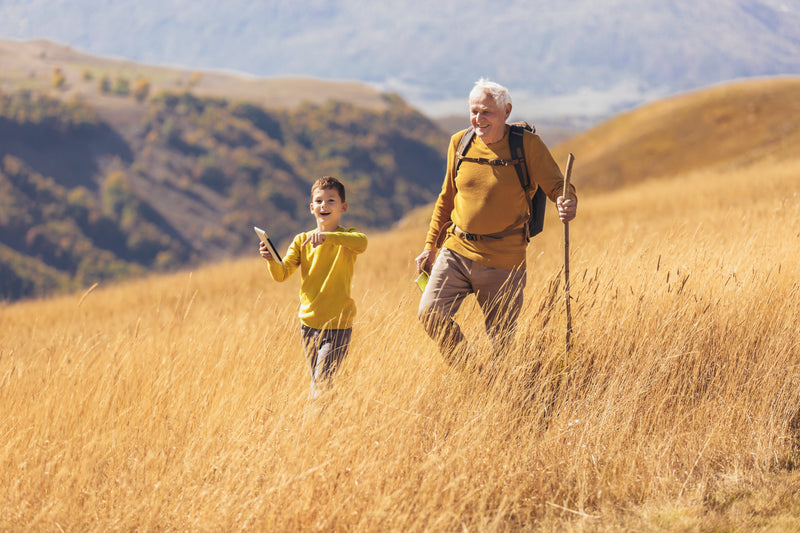
Contributed by ELDERLUXE founder Patrick Conboy
Reality hit me two years ago. First an A-Fib heart issue, high blood sugar, then an unrelated blood infection, cholesterol and... overweight. I felt like a ticking time bomb. And, I was. I was on a road I hadn't traveled before, but it was one my late father Jack had journeyed upon. Shared genetics and lifestyle choices now had me hurriedly retracing my own journey's route to avoid an early exit ramp.
I never gave myself the time to commit to daily workouts- an occasional trip to the gym here, pickup basketball, golf, tennis there... but nothing that I considered sustainable. With a move for myself, and my business to Texas, I decided it was also time for a move in lifestyle dynamics to something of a healthier lifestyle. I would focus on two aspects of my life that aren't a big surprise: 1. Eat Healthier and 2. Exercise. I'll be back to tell you more on how I tackled number one in another post, another time.
It was then (and now) I discovered what I would entitle "The Powerful Benefits of Daily Walking for Adults Over 50".
Walking might be the most underrated form of exercise out there. No gym membership required, no fancy equipment, no complicated moves to memorize—just put one foot in front of the other. For adults over 50, walking daily can be one of the best ways to protect your health, strengthen your body, and brighten your mood.
So there it was. Every day starting 2 years ago, I decided I would walk. At first 10,000 steps. Then let's call it 4 miles, then 5. DAILY. I get up at 5:30 (or so) before met with the Texas sun and roll down to a local trail here in Dallas and walk those steps, reaching a familiar landmark, turn and retrace. I even jog a bit when feeling more ambitious. So far the results have been beyond my expectations. Down 45 lbs. - on my way to a goal of 50+ with better cardio performance, more energy, stabilized health and more happy.
You can realize the many benefits too, with science to back it up!
Walking:
1. Supports Heart Health
Walking regularly strengthens the heart and lowers blood pressure, which can reduce the risk of heart disease and stroke. According to the American Heart Association, walking at least 30 minutes a day can help reduce cardiovascular disease risk factors like high blood pressure and high cholesterol (AHA, 2019). TIP, try Nordic walking sticks- Click https://www.elderluxe.com/collections/nordic-walking-poles-and-trekking-sticks, they increase cardio workout by involving your arms more fully in your walks AND provide a balance assist.
2. Strengthens Bones and Joints
Because walking is a weight-bearing activity, it helps maintain bone density and reduces the risk of osteoporosis. It also lubricates stiff joints and strengthens muscles that support them. The Arthritis Foundation notes that walking can reduce pain, improve flexibility, and even slow down arthritis-related damage.
3. Helps Manage Weight and Blood Sugar
A daily walk is a steady calorie-burner that supports weight management. Beyond weight control, it also improves insulin sensitivity, helping regulate blood sugar. Research from the American Diabetes Association shows that regular walking can reduce the risk of type 2 diabetes and help manage the condition for those who already have it (ADA, 2018).
4. Improves Balance and Reduces Fall Risk
Falls are one of the greatest health concerns for adults over 50, but walking strengthens core muscles and improves balance. The Centers for Disease Control and Prevention (CDC) recommends walking and similar activities to maintain strength and coordination as we age.
5. Boosts Brain Health
Daily walking doesn’t just help the body—it sharpens the mind too. A study published in Neurology (2010) found that older adults who walked regularly had more gray matter volume in the brain, which is linked to better memory and reduced dementia risk. Walking increases blood flow to the brain, keeping it active and healthy. I know I do some of my best thinking on my daily sojourn.
6. Lifts Mood and Reduces Stress
Walking helps release endorphins—the body’s natural “feel-good” chemicals—while reducing cortisol, the stress hormone. The Mayo Clinic reports that regular moderate exercise, like brisk walking, can ease symptoms of anxiety and depression and promote a better sense of well-being.
7. Improves Sleep and Energy
A brisk walk in fresh air during the day can help you fall asleep faster and stay asleep longer. The Sleep Foundation notes that moderate-intensity aerobic activity improves sleep quality, especially in older adults. Plus, walking boosts circulation and oxygen flow, leaving you more energized during the day.
8. Encourages Social and Emotional Connection
Walking with a friend, partner, or group makes it more enjoyable and provides accountability. Social activity is linked to reduced loneliness and better mental health, according to the National Institute on Aging (NIA). I'd also say having someone who supports and encourages you is a huge advantage and emotional lift.
How Much Walking Is Enough?
Even a 20–30 minute walk most days of the week adds up to big health benefits. The CDC recommends at least 150 minutes of moderate-intensity activity per week for older adults, and walking fits the bill perfectly. My walks tend to last a little over one hour.
Final Word
Walking daily after 50 is about much more than fitness. It’s about maintaining independence, improving quality of life, and feeling good inside and out. Whether it’s a stroll through the neighborhood, a walk at the mall, or a nature trail, every step you take is an investment in your future self.
So, lace up your shoes, grab a friend (or a walking stick for extra support), and step into better health—one stride at a time.
AgeWell, friends.
-P
References:
American Heart Association. (2019). Walking and Your Heart Health.
Arthritis Foundation. (2022). Why Walking Is the Perfect Arthritis Workout.
American Diabetes Association. (2018). Physical Activity/Exercise and Diabetes.
Centers for Disease Control and Prevention. (2022). Physical Activity for Older Adults.
Erickson, K. I., et al. (2010). Physical activity predicts gray matter volume in late adulthood. Neurology, 75(16), 1415-1422.
Mayo Clinic. (2021). Exercise and stress: Get moving to manage stress.
Sleep Foundation. (2022). The Connection Between Exercise and Sleep.
National Institute on Aging. (2021). Participating in Activities You Enjoy As You Age.



0 comments